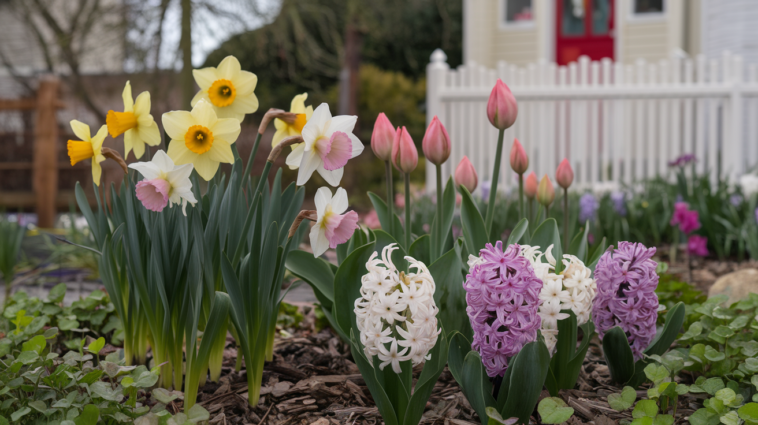Spring is the time to bring your garden to life with easy and fun ideas that can brighten up your outdoor space. Whether you’re a seasoned gardener or just starting out, these 15 simple concepts will help you create a vibrant garden that’s all about enjoying the season. Let’s dig in and explore some creative ways to spruce up your green thumb activities!
Vertical Gardening Solutions
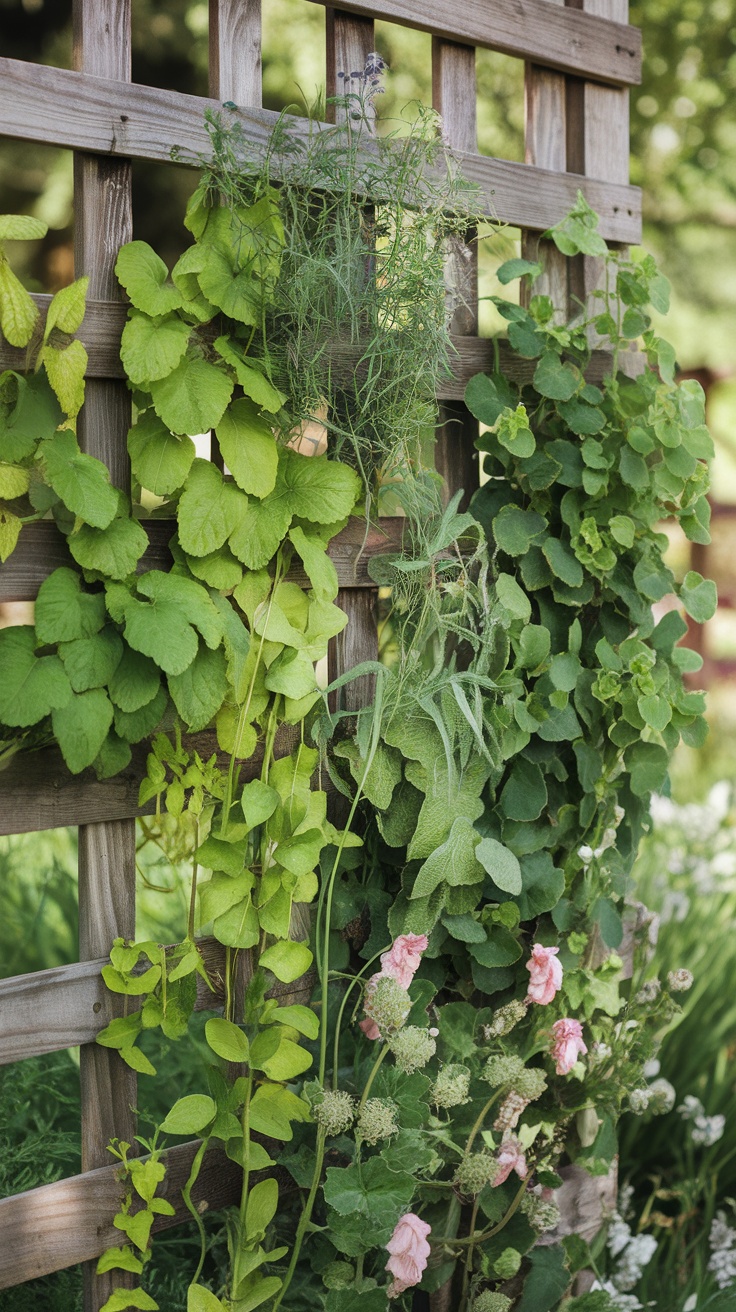
Vertical gardening is a fun and creative way to maximize space and add greenery to your home or garden. The image shows a wooden trellis adorned with various climbing plants and herbs. This setup not only looks inviting but also utilizes vertical space effectively.
Using a trellis allows plants to grow upward, which is perfect for small areas or patios where ground space is limited. You can grow a variety of plants like vines, herbs, or even flowers, giving you both beauty and functionality.
Consider mixing different types of plants for a vibrant look. For example, you might combine herbs like basil and parsley with flowering plants. This diversity not only creates visual interest but also attracts beneficial pollinators to your garden.
Vertical gardening can also be a great project for kids. They will enjoy watching their plants grow and can learn about gardening in a hands-on way. Plus, it’s a fantastic way to introduce them to caring for the environment.
DIY Raised Garden Beds
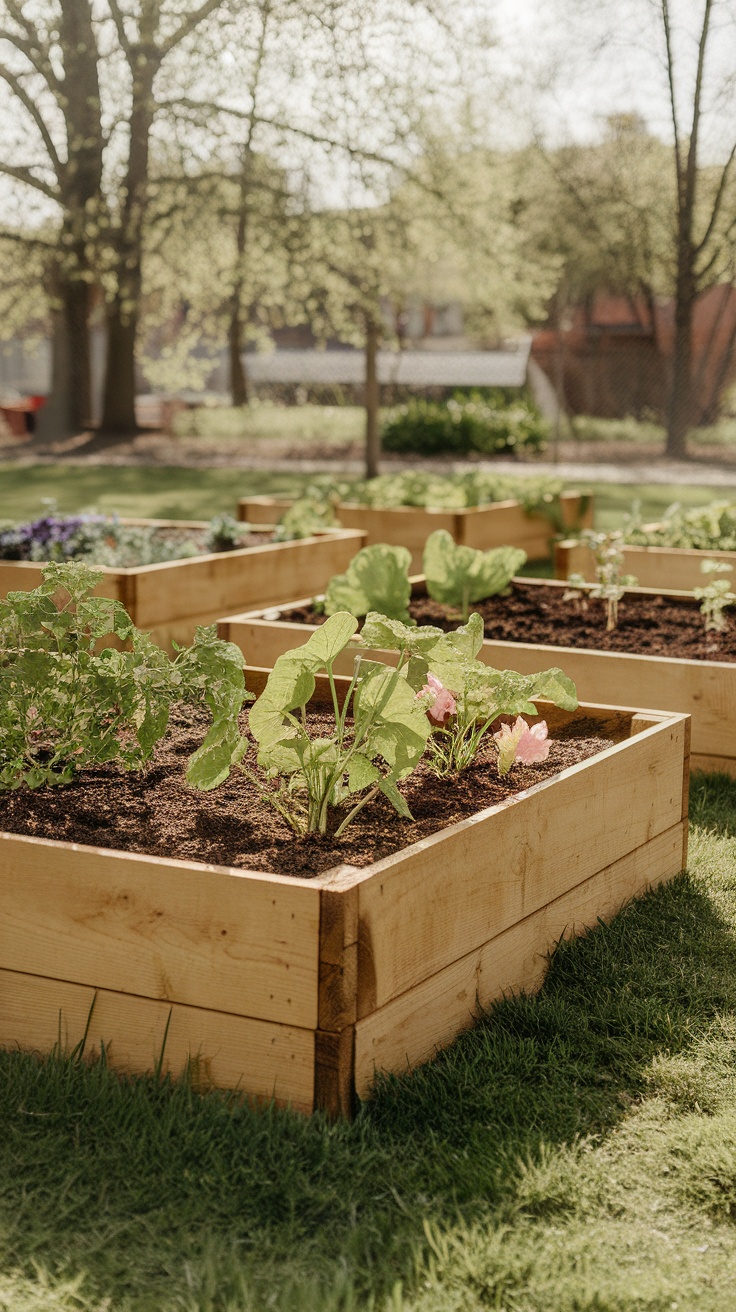
Raised garden beds are a fun way to get into gardening. They offer better soil control and can help with drainage, making it easier to grow healthy plants. In the image, you can see several wooden raised beds filled with vibrant green plants. Each bed is well-defined, showing off the neat layout that makes gardening more organized.
The warm sunlight filtering through the trees gives the whole scene a cheerful vibe. The plants peeking out from the soil are thriving, indicating that they are getting the right care. This setup not only looks good but is also practical, as it can reduce the strain on your back when tending to your garden.
Building your own raised garden beds is relatively simple. You just need some wood, soil, and plants to get started. You can customize the size to fit your space and choose the kinds of plants that you want to grow. It’s an enjoyable project that can enhance your outdoor area while providing fresh produce or lovely flowers.
Creating a Cozy Outdoor Seating Area
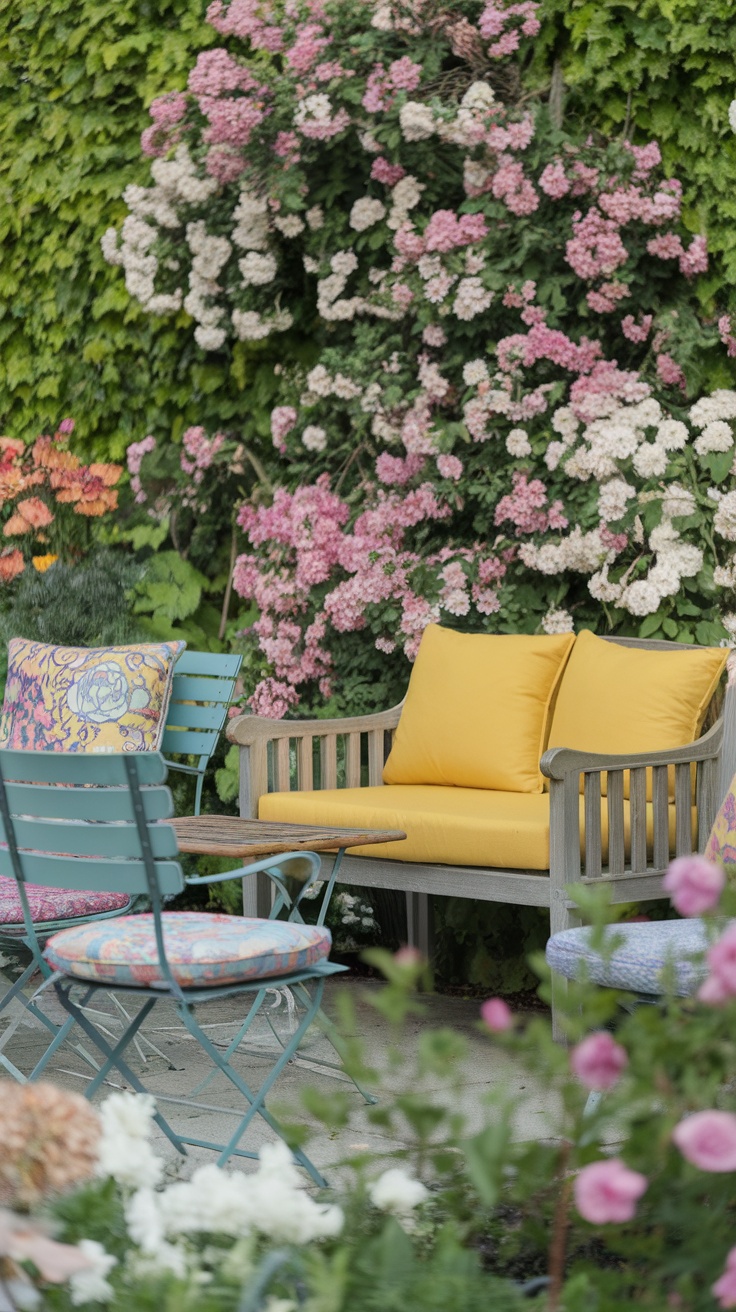
Spring is the perfect time to create a cozy outdoor seating area in your garden. Imagine a lovely spot surrounded by vibrant flowers. In the image, you can see a charming arrangement of seating options that invites relaxation.
The main seating feature is a comfortable wooden bench with bright yellow cushions. This pop of color adds warmth and cheer to the space. Next to it, there are additional chairs with soft, patterned cushions, offering a playful touch. These seats provide plenty of room for family and friends to gather.
To enhance the atmosphere, the backdrop is filled with lush greenery and blooming flowers in shades of pink and white. This natural beauty creates a peaceful and inviting setting. A small table sits in the center, perfect for holding drinks or snacks while you enjoy the fresh air.
This cozy area is ideal for morning coffee or evening chats. You can easily personalize your seating with cushions and throws to make it even more inviting. Remember to consider the layout to ensure it fits well within your garden, allowing for easy movement and access to the surrounding plants.
Incorporating Edible Flowers
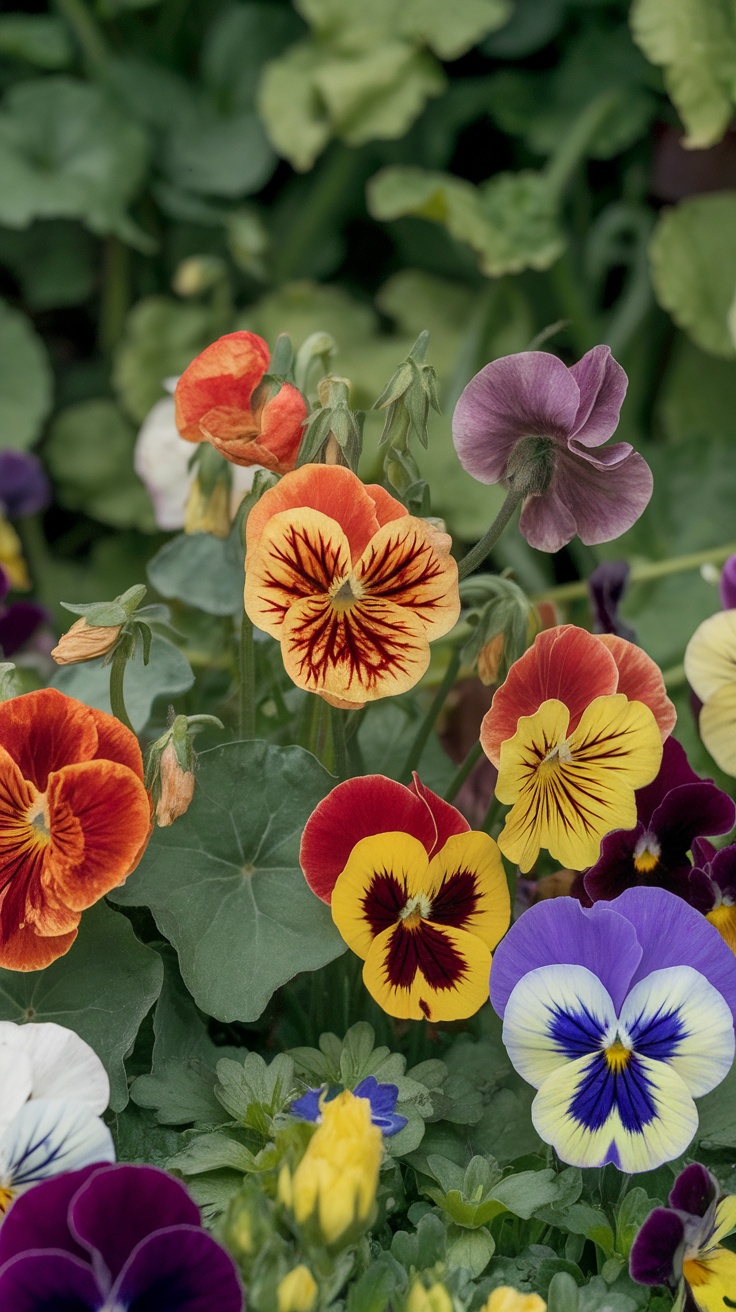
Spring is a fabulous time to add edible flowers to your garden. Not only do they look pretty, but they can also bring a burst of flavor to your meals. Just look at the vibrant pansies in the image! Their colors range from deep purples to bright yellows, making them a cheerful addition to any garden.
Edible flowers like pansies are not just for decoration. You can toss them into salads for a splash of color and taste. They have a mild, slightly sweet flavor that can elevate any dish. Try placing them on top of a cake or using them in a refreshing drink for a fun twist!
Planting these flowers is simple. They thrive in sunny spots with well-drained soil. Just make sure you give them enough water, especially as the weather warms up. Regular deadheading will encourage more blooms throughout the season.
Want to try something unique? Combine your pansies with nasturtiums, which have a peppery flavor. This mix can add both beauty and taste to your garden and your plate. Enjoy experimenting with different edible flowers and see how they brighten up your culinary creations!
Planting Pollinator-Friendly Flowers
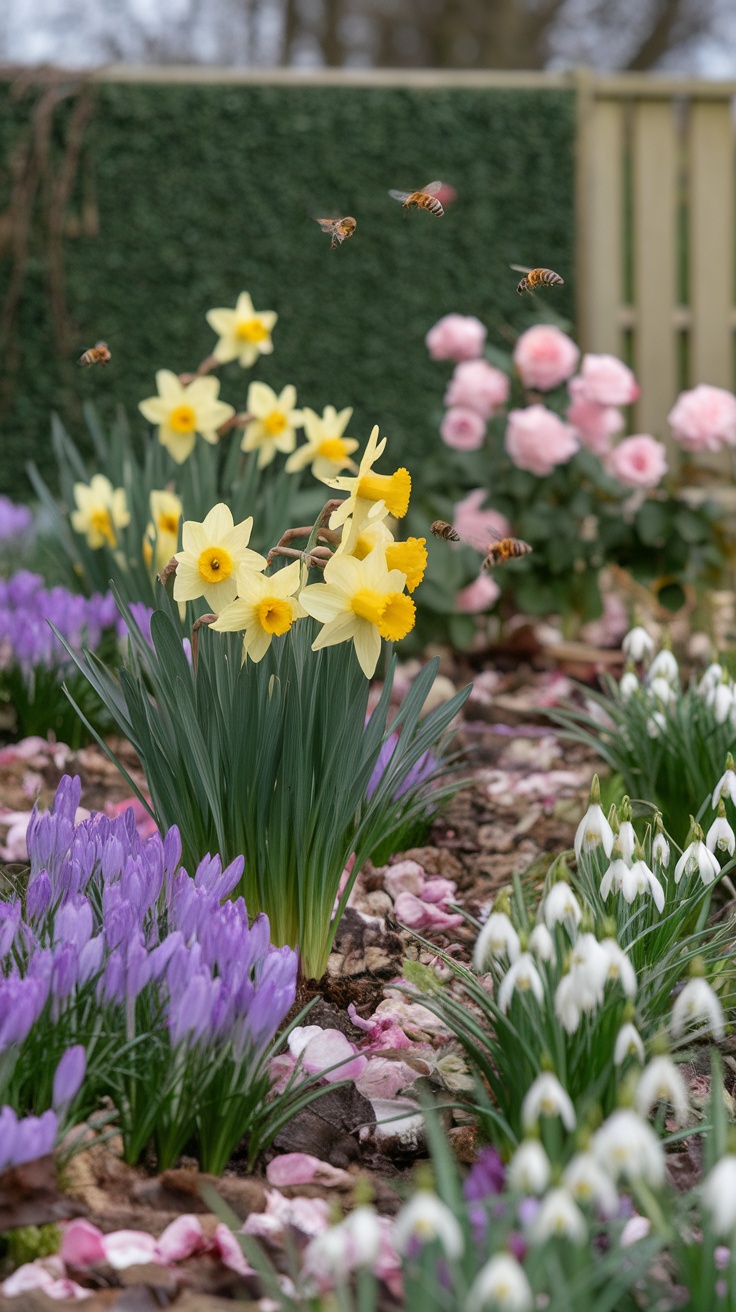
Spring is a beautiful time to plant flowers that attract pollinators like bees and butterflies. The image shows a vibrant garden filled with cheerful daffodils, delicate crocuses, and elegant snowdrops. Bees can be seen buzzing around the bright daffodils, showcasing their essential role in our ecosystem.
Choosing flowers that bloom at different times can create a continuous source of nectar for pollinators. Daffodils bloom early in the season, while crocuses and snowdrops follow closely behind. This diversity not only benefits the pollinators but also keeps your garden colorful throughout spring.
When selecting flowers, consider native plants as they are well-suited to your local climate and often require less maintenance. Flowers such as lavender, echinacea, and sunflowers are wonderful choices. They provide food and habitat for various pollinators, enriching your garden’s biodiversity.
Don’t forget to plant in clusters! Grouping flowers together makes it easier for pollinators to find them. A patch of brightly colored blooms will attract more bees and butterflies than scattered plants. Creating a welcoming environment in your garden helps support these vital creatures.
Succulent Garden Arrangements
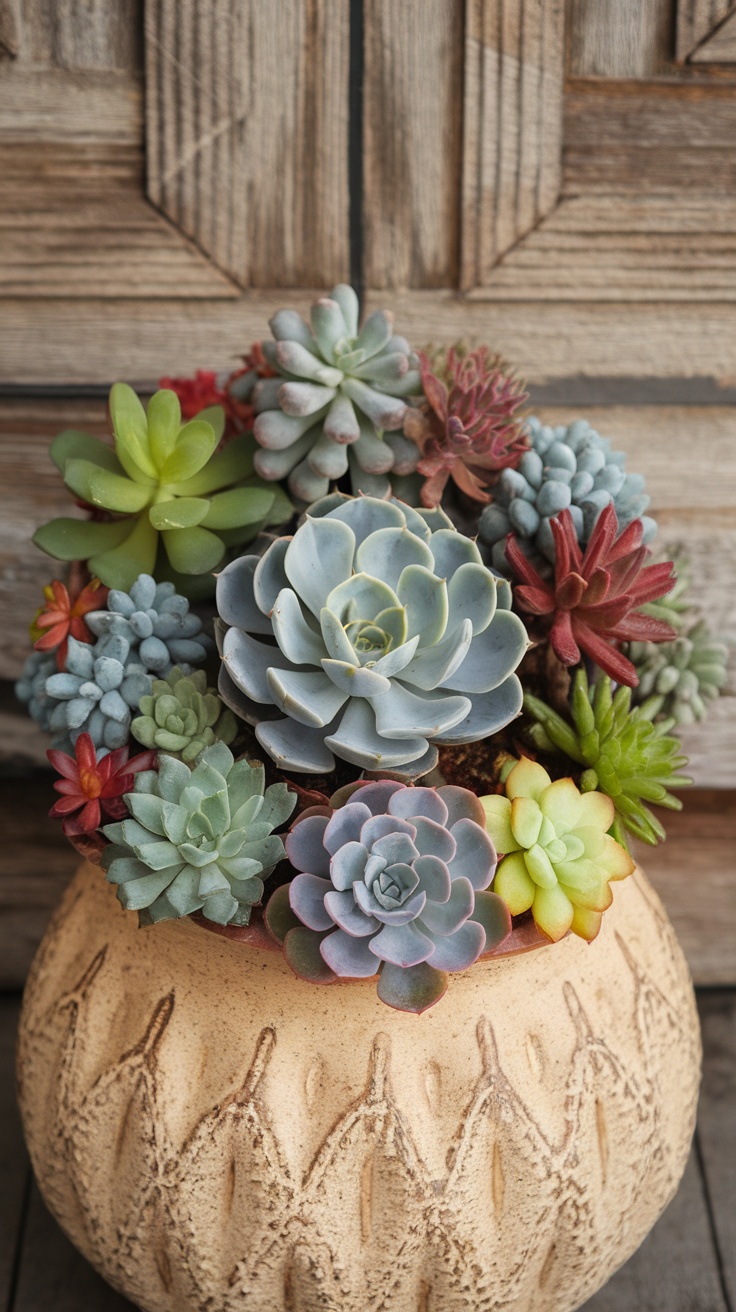
Creating a succulent garden arrangement is a fun and rewarding project for spring. Succulents come in various shapes, sizes, and colors, making them easy to mix and match. The image shows a lovely assortment of succulents beautifully arranged in a textured pot. This type of arrangement can serve as a centerpiece on your patio table or as a vibrant addition to your indoor decor.
To start, choose a pot with good drainage. The design shown here features earthy tones, which complement the green and colorful succulents. Next, select your succulents; you might want to include varieties like Echeveria, Sedum, or Haworthia for diverse textures and hues. Ensure your chosen plants thrive in similar lighting conditions.
When planting, fill the pot with succulent soil, which is specially formulated to promote drainage. Arrange the succulents in the pot, placing taller varieties in the back and shorter ones in front for depth. Don’t worry if the arrangement isn’t perfect; nature is all about organic beauty!
Lastly, give your new garden a gentle watering. It’s essential to let it dry out between waterings, as overwatering is a common mistake. With minimal care, your succulent arrangement will flourish and bring joy throughout the season.
Herb Spiral Garden Design
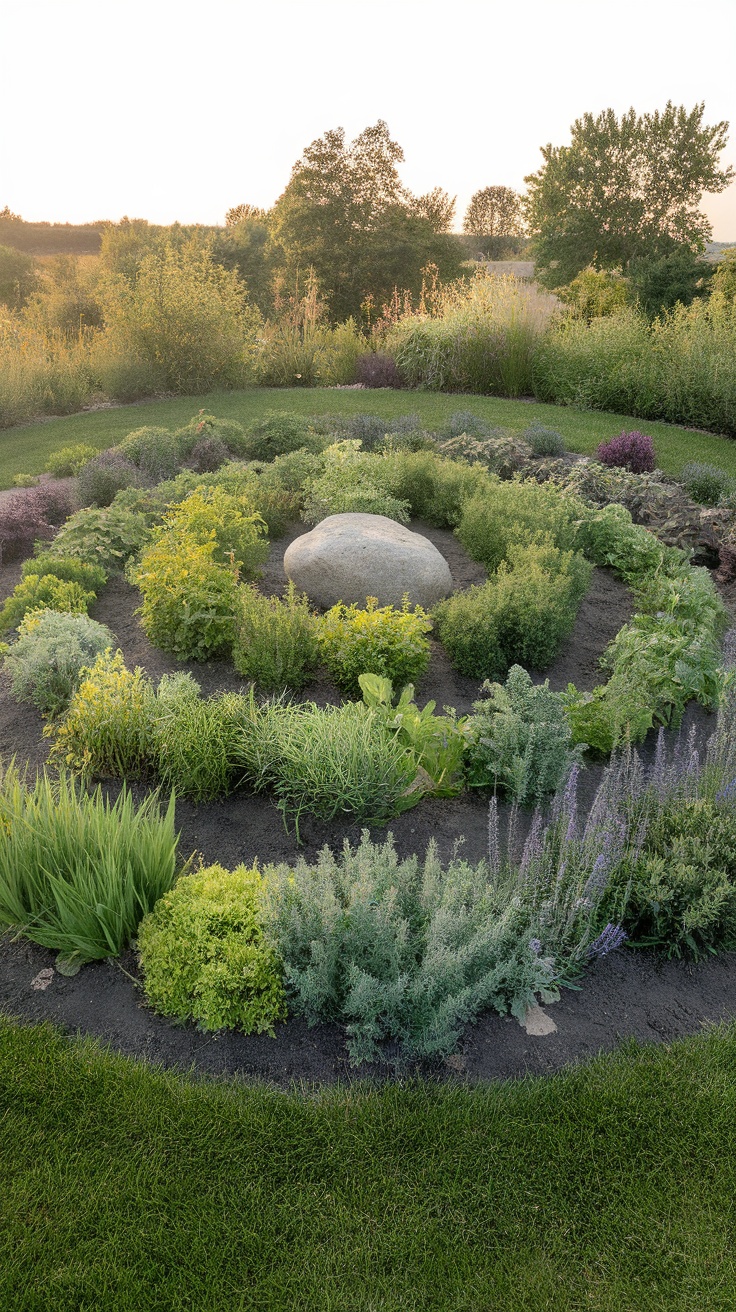
An herb spiral garden is a creative way to grow your favorite herbs in a compact space. The design features a spiral shape that allows for various microclimates, which benefits different types of plants.
In the image, you can see a beautifully arranged herb spiral. The central stone adds a rustic touch and serves as a focal point. Around it, lush green herbs are thriving, showcasing various textures and colors. The circular layout not only looks appealing but also maximizes your gardening space.
This design is perfect for small yards or patios. You can easily access herbs at different heights, making it convenient for cooking or garnishing your dishes. Plus, the spiral structure encourages good drainage and air circulation, which are essential for healthy plants.
To create your own herb spiral, start by choosing a sunny spot. Gather materials like soil, rocks, and your favorite herbs. As you build up the spiral, plant herbs that prefer different levels of moisture, placing the thirstiest ones at the bottom and the drought-tolerant ones at the top. This simple approach not only helps your herbs thrive but also adds a unique feature to your garden.
Container Gardening for Small Spaces
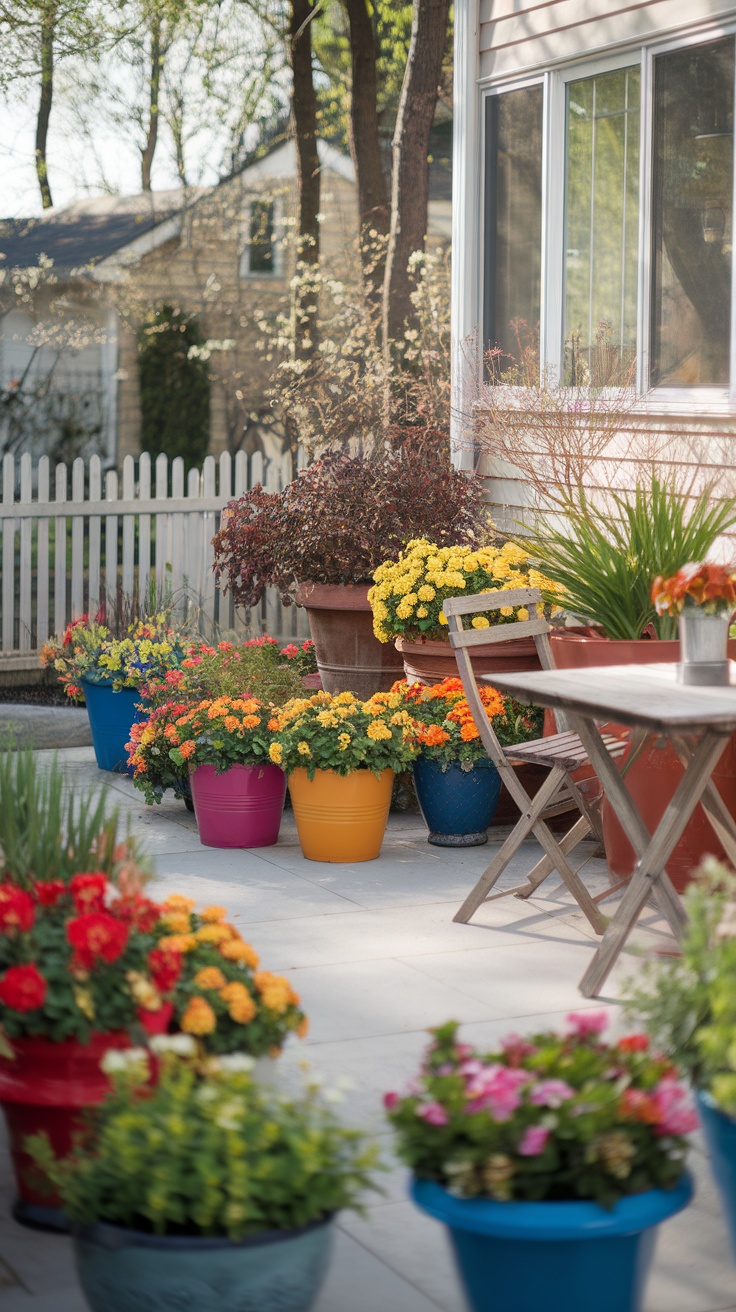
Container gardening is a fabulous way to enjoy plants, especially in smaller spaces. The image here beautifully showcases a variety of colorful pots filled with vibrant flowers, creating a cheerful atmosphere. Each pot offers a unique splash of color, making the area feel alive and inviting.
For those with limited room, using containers allows you to maximize your gardening potential. You can mix and match sizes and colors, just like in the photo, to create a dynamic and playful look. Whether it’s a balcony, patio, or a small yard, plants in containers can brighten your space and enhance its charm.
Consider using herbs, vegetables, or seasonal flowers in your pots. They’re easy to maintain and can fit into any nook or cranny. Just remember to choose the right potting mix and ensure adequate drainage. This will help your plants thrive, just as the lively ones in the image seem to.
Creating a Wildlife-Friendly Space
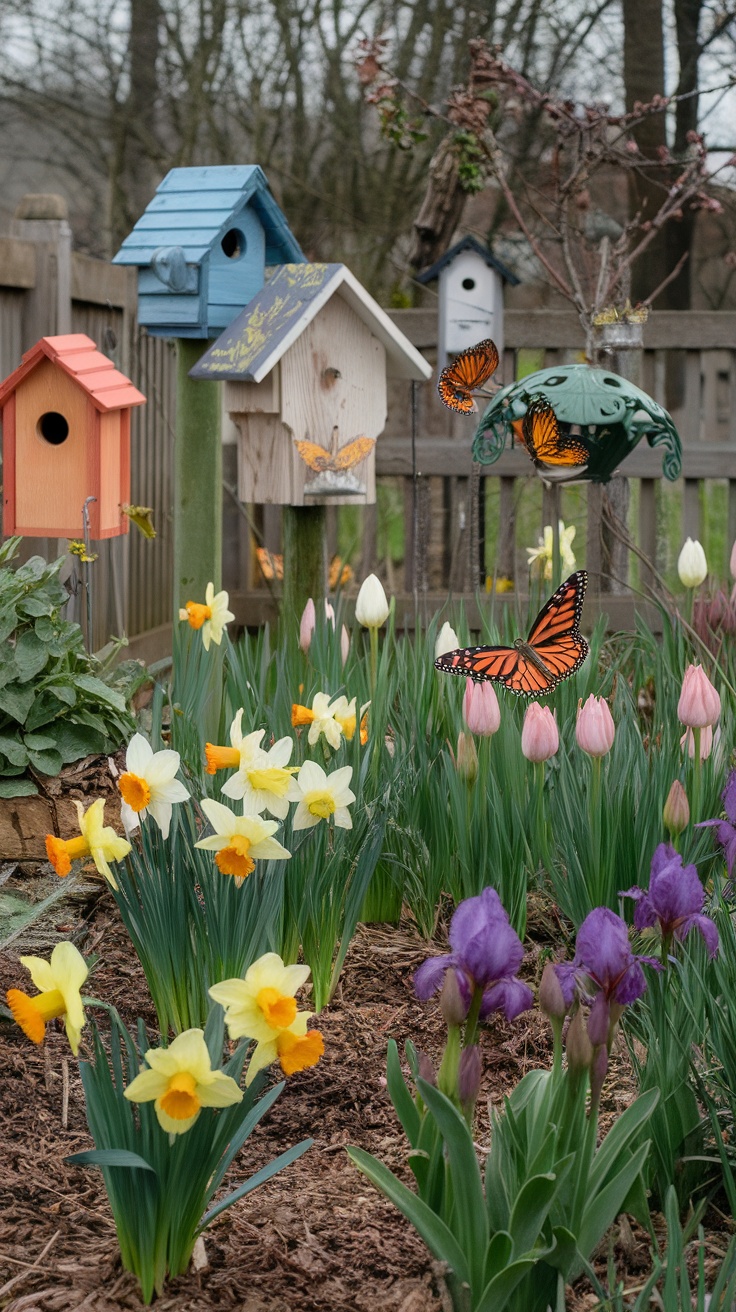
Creating a wildlife-friendly garden can bring a lot of joy and beauty to your outdoor space. In this vibrant garden scene, you see a mix of colorful flowers, like daffodils and tulips, providing a feast for the eyes and a habitat for various creatures.
Birdhouses are scattered around, inviting birds to nest and raise their young. These charming homes add character and are practical, too. They encourage local bird populations to thrive, while also offering delightful birdwatching opportunities.
Butterflies flutter about, attracted by the blooming flowers. By planting a variety of nectar-rich plants, you can create a haven for butterflies and other pollinators. Consider adding some native plants to your garden; they are often the best choices for supporting local wildlife.
Using mulch in the garden bed helps retain moisture and provides shelter for beneficial insects. A healthy mix of flowers and plants can turn your garden into a lively ecosystem. By making these simple changes, you’re not just beautifying your space but also playing a vital role in supporting local wildlife.
Building a Garden Pathway
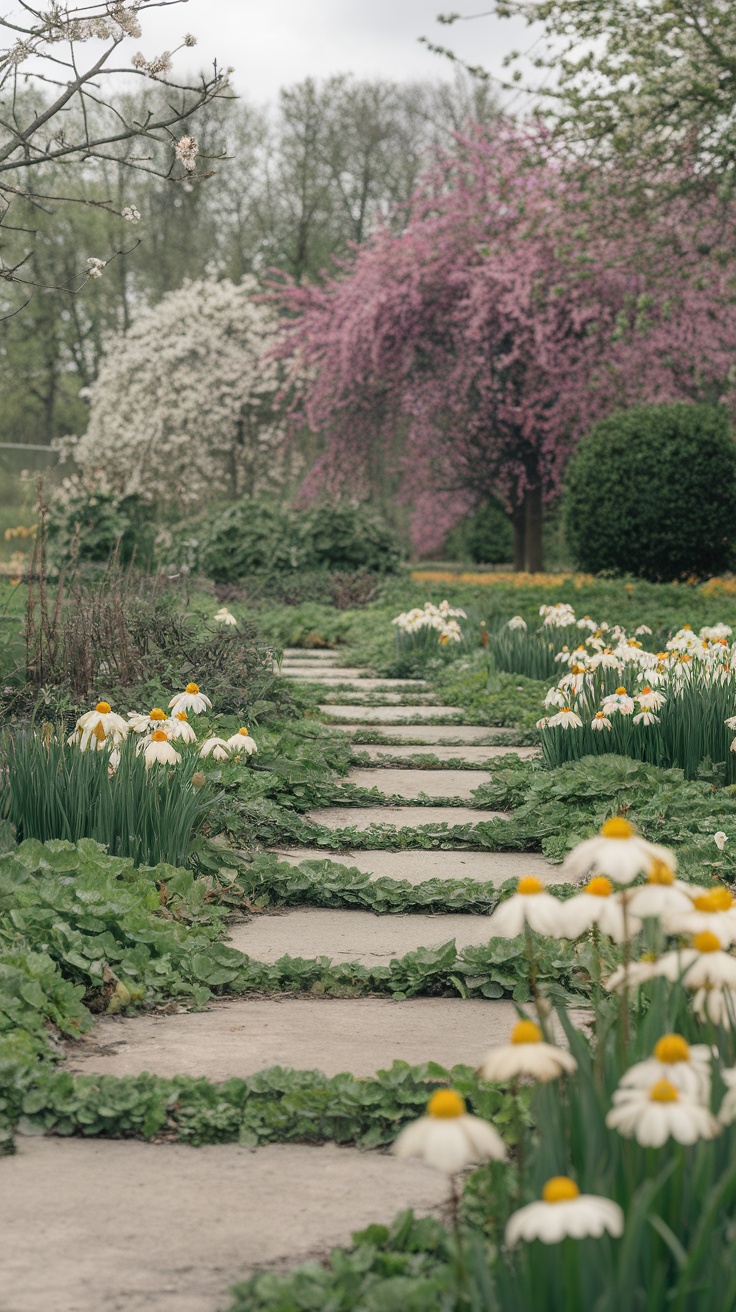
Creating a garden pathway is an enjoyable project that can enhance the beauty of your outdoor space. The image shows a lovely stone pathway framed by vibrant flowers and lush greenery. This not only provides a clear route through your garden but also adds to its charm.
To start building your pathway, choose materials that complement your garden’s style. Stones, bricks, or pavers can create a rustic feel, while concrete offers a modern touch. Lay them down in a way that guides visitors through your garden, allowing them to appreciate the flowers along the sides.
As seen in the image, incorporating plants like daisies and ground cover can soften the edges of your pathway. This greenery not only looks inviting but also helps to keep the path defined. Consider adding small lights along the edges for a warm glow during evening strolls.
Don’t forget to maintain the plants on either side! Regular trimming will keep the pathway clear and ensure that blooms are always vibrant. With a bit of effort, your garden pathway will be a delightful feature that invites everyone to explore your blooming paradise.
